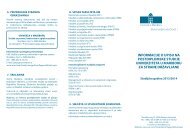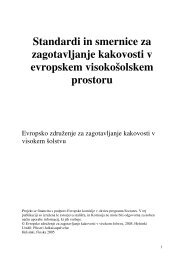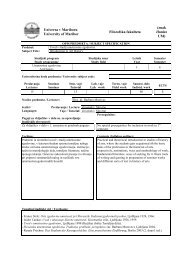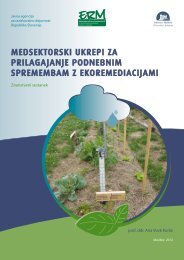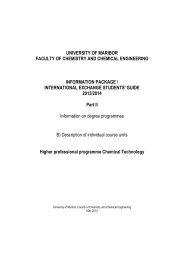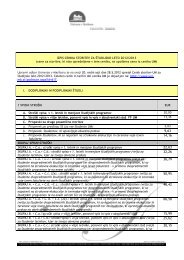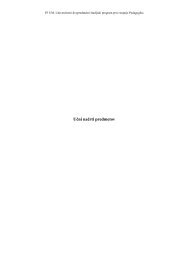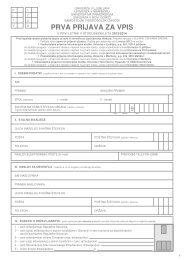FF UM, Univerzitetni dvopredmetni študijski program prve stopnje Sociologija• Vpliv biomedicinskega modela nakomunikacijo in medsebojne odnose vnegi starostnikov;• Uporaba in vpliv različnih teorij nakomunikacijo in medsebojne odnose vnegi starostnikov;• Verbalna in neverbalna komunikacija vnegi starostnikov;• Terapevtska komunikacija in družinastarostnika;• Tehnike terapevtske komunikacije;• Starostnik, družina in zdravstveni teamv terapevtskih medsebojnih odnosih;• Medsebojni odnosi med družino,starostnikom in teamom zdravstvenenege;• Medsebojni partnerski odnosi vzdravstveni negi;• Pomen humane komunikacije inmedsebojnih odnosov za pacienta inčlane negovalnega tima v oskrbistarostnika.Temeljni literatura in viri / Textbooks:• Basic knowledge and competenciesnecessary to prepare the student to functionas an entry-level nursing care provider.• Use and impact of different approacheswhen practicing basic nursing care skills.• Dimesnions of verbal and non-verbalcommunication with the lederly• Elderly and the family• Basic organizational managementtechniques to the unique demands of agingservices in the public and private sectors.• Unique customer, regulatory, ethical, quality,and delivery issues of providing services toindividuals in living various settings andranging from older adults who are fullyactiveand productive to those facing limited health,incomes, cognitive function or social support.1. Balzer Riley, J (2000). Communication in Nursing. 4th Edition. St. Luis: Mosby.2. Clark, A (2001). The Sociology of Healthcare. Harlow: Prentice Hall.3. Duxbury, J (2000). Difficult Patients. Oxford: Butterworth-Heinemann.4. Ellis, RB, Gates, B, Kenworthy (2003). Interpersonal Communication in Nursing. 2nd Edition. Edinburgh:Churchill&Livingstone.5. Ellis, RJ, Hartley, CL (2004). Nursing in Today's World. Trends, Issues &Management. 8th Edition.Philadelphia: Lippincott Williams & Wilkins.6. Ellis, RJ, Hartley, CL (2005). Managing and Coordinating Nursing Care. 4th Edition. Philadelphia:Lippincott Williams & Wilkins.7. Rungapadiachy, DM (2003). Medosebna komunikacija v zdravstvu. Ljubljana: Educy.8. Sundeen SJ, Stuart, GW, Rankin, EAD, Cohen, SA (1998). Nurse-Client Interaction. Implementing theNursing Process. 6th Edition. Mosby Year Book. St.Luis: Mosby.9. Ule, M (2003). Spregledana razmerja. Maribor: Aristelj.10. Ule, M (2002). Psihologija komunikacije,Aristej,Maribor.Cilji:Cilji in vsebina predmeta, ki zajemajo teoretskokonceptualizacijo sociološkega in zdravstvenonegovalnegarazumevanja komunikacije sstarostniki, v svoji zastavitvi izhajajo iz kombinacijesociološke sistematike in problemskega pristopa terprilagajanja splošnih zdravstvenih in negovalnih tersocioloških sklopov povezanih disciplin tako, da:• študent doume vlogo in dinamiko družbenih insocio-ekonomskih in družbenih sprememb, kiimanentno vplivajo na kvaliteto življenjastarostnikov v postmoderni družbi tervzpostavljanje razmerja v komunikaciji na ravnidružba, družina, institucije, ki skrbijo zastarostnika ter starostnikom, nastanek in razvojustrezne in specifične komunikacije sObjectives:This course is a sociological exploration of the agingprocess with focus on communication betweenelderly and the rest of the society It focuses onnursing issues. It examines perspectives and socialimpacts of aging, including differences in culture,race, gender, and social class. By the end of thecourse, students will• Be aware of the dynamic relationshipsbetween social forces and the individual lifecourse (e.g., demographic changes, cohortsuccession, period effects); Be able todistinguish between universal and culturespecific aspects of aging; Be aware ofunderlying cultural norms and values thatshape the experience of gender and aging;98
FF UM, Univerzitetni dvopredmetni študijski program prve stopnje Sociologijastarostniki, ki sega od socioloških znanj dopridobivanja za starostnika želenih informacij,ki segajo od občih socioloških do specifičnihzdravstvenih kategorij(npr, družba in starostniki,institucije za oskrbo starostnikov, izobraževanjev tretjem oz.četrtem življenjskem obdobju, vrstein načini komuniciranja, vloga družinestarostnika, akulturacija, integracija idr.) doposebnih socioloških in medicinskih terzdravstvenih disciplin (sociologija zdravja inbolezni, sociologija zdr. nege. Socialnagerontologija, sociologija vzgoje starostnikov,sociologija potrošnje idr.), kar omogočapridobivanje reflektiranega razmerjastarostnika, institucij za njih oskrbo, družine indrugih do socialnega in do mesta starostnika vnjem;• študent doume vlogo in pomen družbenepogojenosti staranja, modernizacije staranja indružbene pogojenosti starostnikov v izgradnjilastne identitete in njeno vpletenost vdeskriptivno, normativno in pravno komponentosodobenga razumevanja oskrbe inkomunikacije s starostniki v postmoderni družbi,ko so tako starostnikova družina, zdravstveni innegovalni team, katerih sodelovanje temelji naafektivnih odnosih, v sicer različnihorganizacijskih (in drugih) oblikah v procesihkomunikacije in v prenašanju kulturnega insocialnega kapitala skozi različne proceseinterakcij nenadomestljivi za starostnika indejavnike socialnega okolja, v katerem le-taživi.Predvideni študijski rezultati:Znanje in razumevanje:Študent se usposobi za prepoznavanje strukturnihsprememb in potreb starostnika v komunikacijskihprocesih v postmodernosti, ki se odražajo naspremenjenih odnosih do starostnika in njega doostalih starostnih kohort ter na statusu starsostnikain njegovi vlogi v postmoderni družbi, vrednotenjuustrezne in potrebne komunikacije in interakcije znjim ter za optimalno prepoznavanje in sodelovanjev njegovem življenju;Študent se usposobi za prepoznavanje globokosocialno strukturiranih in konstruiranih značilnostistaranja, značilnosti tega življenjskega poteka inobdobja, delovanje družine starostnika,zdravstvenega in negovalnega teama v sodobnipostmoderni družbi.Prenesljive/ključne spretnosti in drugi atributi:• sposobnosti samostojnege in avtonomnekomunikacije s starostniki;• prepoznavanje procesa staranja v širšem,družbeno-kulturnem kontekstu;• pripravljenost na pomoč starostnikom.Have a working knowledge of thedevelopment and nature of income securityprograms and health care policy.• Become more sensitive towards issues andconcerns of older people; Understand thataging is a life-long process - it does not startat 65; Be able to reflect on and construct anold age worthy of "our future selves."Adeeper understanding of aging requires,however, that we move beyond ourindividual experiences and broaden our viewto understand how processes from the levelof the individual cell to overall societyinfluence us, and in turn are influenced by usas we progress through life. During thissemester, we will examine various factorsthat affect aging in our society.Intended learning outcomes:Knowledge and Understanding:The student acquires abilities for recognition ofstructural changes in aging in post-modern society,reflecting the changed role and meaning ofperception of the elderly in society that is aging,valuation of partner life, in the transfer of social andcultural capital via various interaction processes.Transferable/Key Skills and other attributes:• ability to communicate with elederly• ability to recognize traits of aging and offamily life of the aged• readiness to assist the elderly, whendysfunction, illness, violence, aggressioncomes about in his family99
- Page 4 and 5:
FF UM, Univerzitetni dvopredmetni
- Page 6 and 7:
FF UM, Univerzitetni dvopredmetni
- Page 8 and 9:
FF UM, Univerzitetni dvopredmetni
- Page 13 and 14:
FF UM, Univerzitetni dvopredmetni
- Page 15 and 16:
FF UM, Univerzitetni dvopredmetni
- Page 17 and 18:
FF UM, Univerzitetni dvopredmetni
- Page 19 and 20:
FF UM, Univerzitetni dvopredmetni
- Page 21 and 22:
FF UM, Univerzitetni dvopredmetni
- Page 23 and 24:
FF UM, Univerzitetni dvopredmetni
- Page 25 and 26:
FF UM, Univerzitetni dvopredmetni
- Page 27 and 28:
FF UM, Univerzitetni dvopredmetni
- Page 29 and 30:
FF UM, Univerzitetni dvopredmetni
- Page 31 and 32:
FF UM, Univerzitetni dvopredmetni
- Page 33 and 34:
FF UM, Univerzitetni dvopredmetni
- Page 35 and 36:
FF UM, Univerzitetni dvopredmetni
- Page 37 and 38:
FF UM, Univerzitetni dvopredmetni
- Page 39 and 40:
FF UM, Univerzitetni dvopredmetni
- Page 41 and 42:
FF UM, Univerzitetni dvopredmetni
- Page 43 and 44:
FF UM, Univerzitetni dvopredmetni
- Page 45 and 46:
FF UM, Univerzitetni dvopredmetni
- Page 47 and 48: FF UM, Univerzitetni dvopredmetni
- Page 49 and 50: FF UM, Univerzitetni dvopredmetni
- Page 51 and 52: FF UM, Univerzitetni dvopredmetni
- Page 53 and 54: FF UM, Univerzitetni dvopredmetni
- Page 55 and 56: FF UM, Univerzitetni dvopredmetni
- Page 57 and 58: FF UM, Univerzitetni dvopredmetni
- Page 59 and 60: FF UM, Univerzitetni dvopredmetni
- Page 61 and 62: FF UM, Univerzitetni dvopredmetni
- Page 63 and 64: FF UM, Univerzitetni dvopredmetni
- Page 65 and 66: FF UM, Univerzitetni dvopredmetni
- Page 67 and 68: FF UM, Univerzitetni dvopredmetni
- Page 69 and 70: FF UM, Univerzitetni dvopredmetni
- Page 71 and 72: FF UM, Univerzitetni dvopredmetni
- Page 73 and 74: FF UM, Univerzitetni dvopredmetni
- Page 75 and 76: FF UM, Univerzitetni dvopredmetni
- Page 77 and 78: FF UM, Univerzitetni dvopredmetni
- Page 79 and 80: FF UM, Univerzitetni dvopredmetni
- Page 81 and 82: FF UM, Univerzitetni dvopredmetni
- Page 83 and 84: FF UM, Univerzitetni dvopredmetni
- Page 85 and 86: FF UM, Univerzitetni dvopredmetni
- Page 87 and 88: FF UM, Univerzitetni dvopredmetni
- Page 89 and 90: FF UM, Univerzitetni dvopredmetni
- Page 91 and 92: FF UM, Univerzitetni dvopredmetni
- Page 93 and 94: FF UM, Univerzitetni dvopredmetni
- Page 95 and 96: FF UM, Univerzitetni dvopredmetni
- Page 97: FF UM, Univerzitetni dvopredmetni
- Page 101 and 102: FF UM, Univerzitetni dvopredmetni
- Page 103 and 104: FF UM, Univerzitetni dvopredmetni
- Page 105 and 106: FF UM, Univerzitetni dvopredmetni
- Page 107 and 108: FF UM, Univerzitetni dvopredmetni
- Page 109 and 110: FF UM, Univerzitetni dvopredmetni
- Page 111 and 112: FF UM, Univerzitetni dvopredmetni
- Page 113 and 114: FF UM, Univerzitetni dvopredmetni
- Page 115 and 116: FF UM, Univerzitetni dvopredmetni
- Page 117 and 118: FF UM, Univerzitetni dvopredmetni
- Page 119 and 120: FF UM, Univerzitetni dvopredmetni
- Page 121 and 122: FF UM, Univerzitetni dvopredmetni
- Page 123 and 124: FF UM, Univerzitetni dvopredmetni
- Page 125 and 126: FF UM, Univerzitetni dvopredmetni
- Page 127 and 128: FF UM, Univerzitetni dvopredmetni
- Page 129 and 130: FF UM, Univerzitetni dvopredmetni
- Page 131 and 132: FF UM, Univerzitetni dvopredmetni
- Page 133 and 134: FF UM, Univerzitetni dvopredmetni
- Page 135 and 136: FF UM, Univerzitetni dvopredmetni
- Page 137 and 138: FF UM, Univerzitetni dvopredmetni
- Page 139 and 140: FF UM, Univerzitetni dvopredmetni
- Page 141 and 142: FF UM, Univerzitetni dvopredmetni
- Page 143 and 144: FF UM, Univerzitetni dvopredmetni
- Page 145 and 146: FF UM, Univerzitetni dvopredmetni
- Page 147 and 148: FF UM, Univerzitetni dvopredmetni
- Page 149 and 150:
FF UM, Univerzitetni dvopredmetni
- Page 151 and 152:
FF UM, Univerzitetni dvopredmetni
- Page 153 and 154:
FF UM, Univerzitetni dvopredmetni
- Page 155 and 156:
FF UM, Univerzitetni dvopredmetni
- Page 157 and 158:
FF UM, Univerzitetni dvopredmetni
- Page 159 and 160:
FF UM, Univerzitetni dvopredmetni
- Page 161 and 162:
FF UM, Univerzitetni dvopredmetni
- Page 163 and 164:
FF UM, Univerzitetni dvopredmetni
- Page 165 and 166:
FF UM, Univerzitetni dvopredmetni
- Page 167 and 168:
FF UM, Univerzitetni dvopredmetni
- Page 169 and 170:
FF UM, Univerzitetni dvopredmetni
- Page 171:
FF UM, Univerzitetni dvopredmetni



